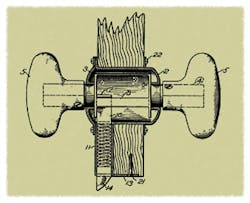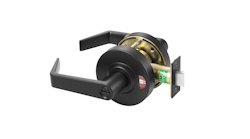Schlage Lock Company developed the "A"-Series knob lock more than 80 years ago. The history of this cylindrical lock is the history of Walter Schlage and the Schlage Lock Company. Walter Schlage was the first person to patent and successfully produce his cylindrical lock.
The story of Walter Reinhold Schlage and the development of the Schlage"A" lock began after he settled in San Francisco in 1905. At the age of 23, he had accepted employment with the Western Electric Company.
During his non-work hours, Walter spent time experimenting with electrical switching ideas. One of the light switch designs in use during this time was a two push button style, where one button was pushed to turn on the lights and a second button was pushed to turn off the lights. The positioning of these buttons indicated whether or not the light bulb was being energized.
During this time, Schlage was developing an idea for controlling room lights using the door knob. This would alleviate the fumbling for the light switch that was positioned somewhere on the wall. In 1909, Walter Schlage's first patent was granted which permitted a light to be switched on and off by turning a door knob. From this first success, he decided to devise a simpler method for locking a door. The result was in 1910, Walter Schlage patented a lock which operated by pushing or pulling on the knob.
Expanding upon his interest in electricity and convenience, Walter developed an indicating push button for an electrical door bell and was granted patents in 1911 and 1913. He then turned his attention back to door locks and patented the Throw-Lock concept in 1916, a lock that could be unlocked by tilting the knob.
Continuing his work to develop a more practical door lock, Walter Schlage determined that two major features had to be built into the lock design. First, the entire lock structure must be able to be stamped 100 percent out of sheet metal to compete with lock manufacturers of the day. Second, the lock could be installed by merely boring two cylindrical holes into the door, one a cross bore and the second, an edge bore. This design was chosen in order to shorten the time required for installation while maintaining the integrity of the door. In addition, a lower cost for installation would encourage interest from the builders in purchasing and installing this lock.
On April 12, 1920, Walter Schlage applied for his first cylindrical-shaped door lock patent. This patent described a lock which was constructed by assembling the knob, spindle and latch retractor into one self-contained unit within a circular housing. The housing had a fixed flange on one side and a clamping plate with two machine screws on the other in order to secure the lock to the door. The body of the lock hooked onto the retractable latch unit. Rotating either knob retracted the latch. Patent 1,456,041 was issued on May 22, 1923.
In 1920, a Certificate of Incorporation was issued by the State of California to the newly formed Schlage Manufacturing Company. The directors were San Francisco businessmen C.P. Griffin, J. Thomkins, and J.H. Morgan. The first board meeting was August 28, 1920. These three gentlemen were the first owners of capital stock, scribing to ten shares each with a par value of $1.00 per share. The company opened its first commercial bank account with a deposit of $30.00.
Deciding that the lock design needed greater functionality, a second patent for the locking push button door lock was filed on Oct. 5, 1920. This patent described a lock of cylindrical construction, with a locking mechanism operated by pushing a button in the center of the interior knob to lock, and by rotating the interior knob to unlock. The plunger, attached to the push button, engaged a spindle on the opposite side, holding the exterior knob in the locked position. The locking push button door lock patent was issued on April 8, 1924, for the predecessor of the"A" lock.
In 1921, Walter Schlage abandoned his previously patented Throw-Lock idea in favor of a push button design. The push-button design was Schlage's ninth application for a patent in the door-lock classification. This design, known as the Schlage Button Lock, incorporated push button locking with the cylindrical housing; the basic design of the Schlage cylindrical push-button lockset we know today.
In 1922, the first Schlage board of directors approved the design and began to tool up for what became the predecessor of the"A" lock. The first installation of Schlage locks were at the Berkeley home of Thomas Castberg, Walter Schlage's patent attorney.
On May 9, 1923, a patent was filed for a key activated rotatable tumbler lock. All previous Schlage locks were non-key operated. This was the first design of the"A" key and lock mechanism. This rocking tumbler design required a double sided key with at least one notch of a specific depth cut into each side. Patent 1,653,511 was granted in December 20, 1927. This key activated rotatable lock design was used until the filing of Patent 1,691,529 in January 1927, when Schlage introduced the seven tumbler wafer lock.
For the purpose of locking, previous locks used the push button design. This lock introduced the possibility of using only a Schlage Lock on an exterior door. The key blank was part number 920A, a center bowed blade with a modified diamond head shape.
On August 20, 1923, Walter Schlage applied for a patent which would become the recognizable"A" lock.
By the end of 1923, the original push button lock dies are completed. Assembly line construction of the"A" lock begins at the new factory at 49 Shotwell St., San Francisco.






